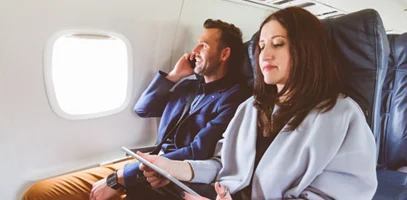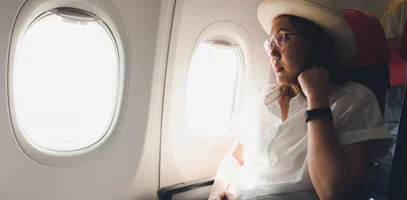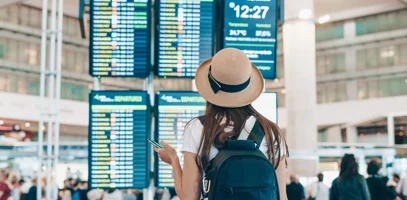Airline Carry-on Luggage Size Restrictions: What You Need to Know
Are you planning a weekend getaway? Or just want to travel with a major airline for business? Regardless, you must understand how much luggage you can bring with you. Most airlines have luggage size and weight restrictions for customers as well as a fee applies when you check bags into the airline’s luggage compartment. However, carry-on luggage is mostly free which you can take along in the aircraft cabin. But do airlines also impose carry-on luggage restrictions?
Well, the answer is yes, airlines' carry-on luggage restrictions are imposed to make sure each passenger can carry bags along for their convenience. These also help you place the bags easily in the airplane cabin. Here in this blog, we explain the details of how airlines impose carry-on restrictions and why. Let’s dive straight into the details.
Why Airlines Have Carry-on Restrictions?
The airlines enforce the carry-on weight and size restrictions for the safety and convenience of the passengers, There is limited space in the overhead bins of aircraft cabins. However, they are meant to accommodate all passengers’ bags, and oversized luggage makes it difficult to place the bags, creating a safety hazard.
They make sure in-cabin bags are not too big or heavy to make sure there are no threats during turbulence or emergency evacuations. Besides, uniform size and weight restrictions help airlines streamline their boarding process, which reduces delays.
Do Airlines Allow To Bring Carry-on Bags For Free?
Yes, several airlines allow you to carry one small bag and a personal item free of charge into the cabin. This is possible with even the most restricted fare type with the airlines, where you do not have a free checked baggage allowance or other flexibilities. Some airlines with free carry-on baggage allowance include;
- Southwest Airlines
- Delta Air Lines
- American Airlines
- United Airlines
- Alaska Airlines
- JetBlue Airways
- Lufthansa
- Air France
- Emirates
- Qatar Airways
- Singapore Airlines
Some airlines which allow free personal items but not carry-on in their basic fare are:
- Frontier airlines
- Spirit Airlines
- Allegiant Air
Few Airlines That charge For Carry-on
- Ryanair
- EasyJet
- Wizz Air
- Vueling
- Norwegian Air Shuttle
Always check the specific airline's policy before you travel, as carry-on allowances can vary by fare type and destination. For example, if you book Delta Airlines tickets at low fares, you can enjoy free carry-on and personal items along with the bookings.
What Are The Standard Dimensions For Carry-on Bags?
Most airlines have similar carry-on luggage dimensions for their customers. The number of bags may vary depending on your fare type and airline, but the dimensions for carry-on luggage remain the same. Here are the average dimensions:
- 22 inches (56 cm) in height: Measured from the bottom to the top of the bag.
- 14 inches (36 cm) in width: Measured from side to side.
- 9 inches (23 cm) in depth: Measured from front to back.
These dimensions are calculated, including the wheels and handles of the bags. This size is determined to fit the overhead compartments on most aircraft seats. The actual dimensional details may vary by the airline. Review your airline’s baggage policy in detail to understand that.
Some examples from the airlines are:
- Southwest Airlines: 10 x 16 x 24 inches (25 x 40 x 61 cm)
- Delta Air Lines: 22 x 14 x 9 inches (56 x 36 x 23 cm)
- American Airlines: 22 x 14 x 9 inches (56 x 36 x 23 cm)
- United Airlines: 9 x 14 x 22 inches (23 x 36 x 56 cm)
- JetBlue Airways: 22 x 14 x 9 inches (56 x 36 x 23 cm)
- Alaska Airlines: 22 x 14 x 9 inches (56 x 36 x 23 cm)
- Lufthansa: 22 x 14 x 9 inches (55 x 40 x 23 cm)
- Air France: 21.7 x 13.8 x 9.8 inches (55 x 35 x 25 cm)
- Emirates: 22 x 14 x 9 inches (55 x 38 x 20 cm)
- Qatar Airways: 22 x 15 x 8 inches (56 x 38 x 20 cm)
Popular Carry-on bag Types
- Spinner Wheels
- Two-Wheeled Rollers
- Duffel Bags
- Tote Bags
- Hardside Luggage
- Softside Luggage
- Backpacks
What Are The Size Restrictions for Personal Items?
You can also carry a personal item along with you in addition to your carry-on bag into the aircraft cabins, The standard size allowance for a personal item is somewhat around 18 X 14 X 8 inches. This can vary depending on your airline. For example, you may get slightly different dimensions for personal items on booking Southwest Airlines flights whereas a bit more or less for Air Canada. Check with your airline beforehand and only then pack your bags.
Types of Allowed Personal Items
- Backpacks
- Tote Bags
- Handbags
- Messenger Bags
- Diaper bags
- Laptop Bags
- Travel Organizers
- Small Duffel Bags
- Camera Bags
- Baby strollers
- Pet Carriers
General Rules for Carry-on Luggage By Airlines
- Most airlines allow one carry-on bag and one personal item (e.g., a handbag, laptop bag, or small backpack).
- Some airline may allow two or three bags to carry along for business or similar higher class passengers.
- Your Pet container will count towards the carry-on bag when traveling with pets, and you will only be allowed to carry one personal item in this case. The same applies to baby strollers,
- The carry-on and personal items dimensions also include handles and wheels.
- The bag must fit in the overhead bin, and the personal item should fit under the front seat.
- Additional charges may apply if you bring overweight or oversized items.
Quick Tips To Comply with Carry-on Restrictions
You must understand and adhere to the airline's carry-on weight and size restrictions to make sure you have a hassle-free journey. Even if you booked tickets using the cheapest fare tools likeCondor Airlines low fare calendar, the same rules will apply. Here’s how you can comply with them and avoid any extra charges:
- Use measuring tape to ensure your bag meets the airline’s size requirements, including wheels and handles. Even a slight overage could result in your bag being checked at the gate.
- Use a portable luggage scale to weigh your bag if your airline has weight restrictions. It’s better to be prepared than surprised at the gate.
- Opt for soft-sided luggage, which is more flexible and easier to fit into tight spaces in overhead bins.
- Expandable bags can lead to size issues if overpacked. Make sure your bag still fits within the airline's size limits when expanded.
- Roll your clothes instead of folding them to save space and help avoid wrinkles.
- Use packing cubes to organize your items and maximize space.
- Remember the TSA’s 3-1-1 rule for liquids in your carry-on. All liquids must be in containers of 3.4 ounces (100 ml) or less, packed in a quart-sized bag.
- Always check the specific airline’s website for the most up-to-date carry-on policies before you start packing. Airlines occasionally update their size and weight restrictions, and what was acceptable on your last flight might not be this time.
What Happens if Your Carry-on is Oversized?
Three situations happen when you have oversized carry-on bags. It is discovered at check-in, at the gate, or during boarding. Here are the details:
1. At Check-in
If your bag is flagged as oversized or overweight at the check-in counter, the airline may require you to check the bag, which often involves additional fees. Depending on the airline and your destination, these fees can range from $30 to $100 or more.
2. At the Gate
Sometimes, an oversized carry-on might only be detected at the gate. In such cases, you’ll likely need to gate-check your bag, which means it will be placed in the cargo hold with the checked luggage. While this usually doesn’t incur a fee, it does mean you’ll have to wait at baggage claim to retrieve your bag after the flight.
3. During Boarding
If the overhead bins are full or your bag is too large to fit, flight attendants may ask you to check your carry-on at the gate. This can be inconvenient, especially if you have a tight connection, as you won’t have access to your bag during layovers.
Connect with lowfarescanners to understand the ins and outs of baggage policy and the airline’s restrictions if your bag is more than the allowed limits.
Carry-on vs. Personal Item: What’s the Difference?
You may understand the exact difference between carry-on bags and a personal item to maximize your packing space and avoid any additional fees. Here are the key differences between the two items:
|
Aspect |
Carry-On Bag |
Personal Item |
|
Definition |
A larger piece of luggage that fits in the overhead bin. |
A smaller bag that fits under the seat in front of you. |
|
Examples |
Small suitcases, duffel bags, larger backpacks. |
Purses, laptop bags, small backpacks, and briefcases. |
|
Size Restrictions |
Typically up to 22 x 14 x 9 inches (56 x 36 x 23 cm), though it may vary. |
Generally around 18 x 14 x 8 inches (45 x 35 x 20 cm). |
|
Purpose |
Ideal for packing the majority of your travel essentials, such as clothes and toiletries. |
Designed for items you need easy access to, like passports, phones, and medications. |
|
Access During Flight |
Not needed during the flight; stored in the overhead bin. |
Accessible during the flight; stored under the seat in front. |
Conclusion
That’s all about the airline’s carry-on weight and size restrictions. If you have more questions, feel free to connect with the lowfarescanners team to learn how you can maximize your space on the plane. Our team may even help you with the booking procedures and managing your bookings.
Recent Post
-

United States Trip Quotes And Captions For Instagram
-

Top 15 Airlines With the Best In Flight Food
-

8 Things You Can Still Get For Free Flying Economy Class
-

What Are Baby Bassinet Seats On The Plane?
-

11 Best Places To Visit In London
-

13 Essentials for Alaskan Cruise Packing List
-

Which Airlines Use Boeing? Lowfarescanners Guide
-

Do Flight Prices Go Down At Night? When to Book
-

7 Important Things To Know Before Booking A Flight
-

Decoding Airline Ticket Prices- How Do Airlines Set Their Fares?
-

7 Amazing Countries To Visit In Asia
-

Top 10 Busiest Airports Worldwide in 2024
-

Black Friday Flight Deals- Are They Really Worth it?
-

The Most Reliable Airlines To Fly- Top 10 Carriers
-

Get Discounted Southwest Flights Every Wednesday
-

Powerful Reasons Why Travel is Important
-

Should you Buy Travel Insurance for your Future Travel
-

Key Mistakes To Avoid On A Plane
-

Best Possible Month for a Cost-Effective International Journey
-

Experience the May Magic- Plan an International Escape in May
-

Get the Best and Exclusive Flight Deals
-

How Do I Avoid Baggage Fees on Flights?
-

Easy Ways & Tips to Get Cheapest Airfare
-

Travel the World on a Budget with LowfareScanners

 Cruise Booking
Cruise Booking Flight Booking
Flight Booking